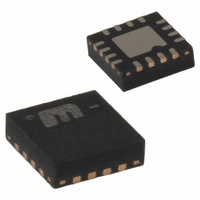SY88982LMG Micrel Inc, SY88982LMG Datasheet - Page 8

SY88982LMG
Manufacturer Part Number
SY88982LMG
Description
IC,Laser Diode/LED Driver,LLCC,16PIN,PLASTIC
Manufacturer
Micrel Inc
Type
Laser Diode Driver (Fiber Optic)r
Datasheet
1.SY88982LMG.pdf
(10 pages)
Specifications of SY88982LMG
Data Rate
2.7Gbps
Number Of Channels
1
Voltage - Supply
3 V ~ 3.6 V
Current - Supply
48mA
Current - Modulation
90mA
Operating Temperature
-40°C ~ 85°C
Package / Case
16-MLF®, QFN
Mounting Type
Surface Mount
Lead Free Status / RoHS Status
Lead free / RoHS Compliant
Other names
576-1452
Available stocks
Company
Part Number
Manufacturer
Quantity
Price
Company:
Part Number:
SY88982LMG
Manufacturer:
Micrel Inc
Quantity:
135
Application Information
The typical applications diagram on the first page
shows how to connect the driver to the laser, single
ended. To improve transition time and laser
response, the laser can be driven differentially as
shown in Figures 3 and 4. Driving the laser
differentially will also minimize the crosstalk with the
rest of the circuitry on the board, especially the
receiver.
DC-Coupling
In addition to the low power consumption and high
modulation current, the SY88982L offers a high
compliance voltage. As can be seen in the “Typical
Operating Characteristics” section (I
curves), the minimum voltage needed at the output
of the driver for proper operation is less than 600mV,
leaving a large headroom, V
with the damping resistor. To show the importance
of this high compliance voltage, consider the voltage
drops along the path from V
laser, damping resistor, and driver:
Ldi/dt is the voltage drop due to the laser parasitic
inductance during I
1nH, t
of I
then Ldi/dt will be equal to 525mV. This number can
be minimized by making the laser leads as short as
possible and using and RC compensation network
between the cathode of the laser and ground or
across the laser driver outputs as shown in Figure 3.
To be able to drive the laser DC-coupled with a high
current, it is necessary to keep the damping resistor
as small as possible. For example, if the drop due to
parasitic inductance of the laser is neglected
(compensated for) and the maximum drop across
the laser (1.6V) considered while keeping a
minimum of 600mV headroom for the driver, then
the maximum damping resistor that allows a 70mA
modulation current into the laser is:
On the other hand, the small is the value of R
higher is the overshoot/undershoot on the optical
signal from the laser. In the circuit shown in Figure 3,
the RC compensation network across the driver
Micrel, Inc.
December 2009
MOD
V
V
V
V
a Fabry Perrot or a DFB laser.
f
R
The worst case will be with V
leading to R
), and I
= t
CC
Rd
laser
band-gap
dmax
f
= Rd x I
= Driver Headroom + V
= 80ps (measured between 20% and 80%
= V
= (V
MOD
+ R
band-gap
CC
MOD
= 70mA (42mA from 20% to 80%),
dmax
-0.6V-1.6V)/0.07A
laser
MOD
+ R
= 11.4Ω
x I
laser
MOD
transitions. Assuming L =
CC
x I
= 1.6V at maximum for
CC
to ground through the
MOD
-600mV, to the laser
Rd
+ Ldi/dt
+ V
MOD
laser
CC
vs. V
= 3.0V,
d
, the
MOD
8
outputs (MOD+ and MOD-) allows the user R
10Ω. The optical eye diagrams at data rates of
155Mbps/622Mbps/1.25Gbps/2.5Gbps,
“Functional Characteristics” section, are all obtained
with the same circuit using R
and C
change from one board to another and from one
type of laser to another. An additional compensation
network (RC) can be added at the laser cathode for
further compensation and eye smoothing.
AC-Coupling
When trying to AC couple the laser to the driver, the
headroom of the driver is no longer a problem since
it is DC isolated from the laser with the coupling
capacitor. At the output, the headroom of the driver
is determined by the pull-up network. In Figure 4, the
modulation current out of the driver is split between
the pull-up network and the laser. If, for example, the
total pull-up resistor is twice the sum of the damping
resistor and laser equivalent series resistance, only
two thirds (2/3) of the modulation current will be
used by the laser. So, to keep most of the
modulation current going through the laser, the total
pull-up resistor must be kept as high as possible.
One solution consists in using an inductor alone as
pull-up, presenting a high impedance path for the
modulation current and zero ohm (0 Ω ) path for the
DC current offering a headroom of the driver equal
to V
into the laser. The inductor alone will cause signal
distortion, and, to improve that, a combination of
resistors and inductors can be used (as shown on
Figure 4). In this case, the headroom of the driver is
V
modulation current that goes through the pull-up
network.
When the laser is AC-coupled to the driver, the
coupling capacitor creates a low-frequency cutoff in
the circuit, and its value must be chosen as large as
CC
-R1 x αI
CC
Comp
and almost all the modulation current goes
= 3pF. The compensation network may
MOD
Figure 3. Laser DC-Coupled
, where αI
hbwhelp@micrel.com
MOD
d
= 10Ω, R
is the portion of the
or (408) 955-1690
M9999-121009-A
SY88982AL
Comp
shown
= 100Ω,
d
in
=











